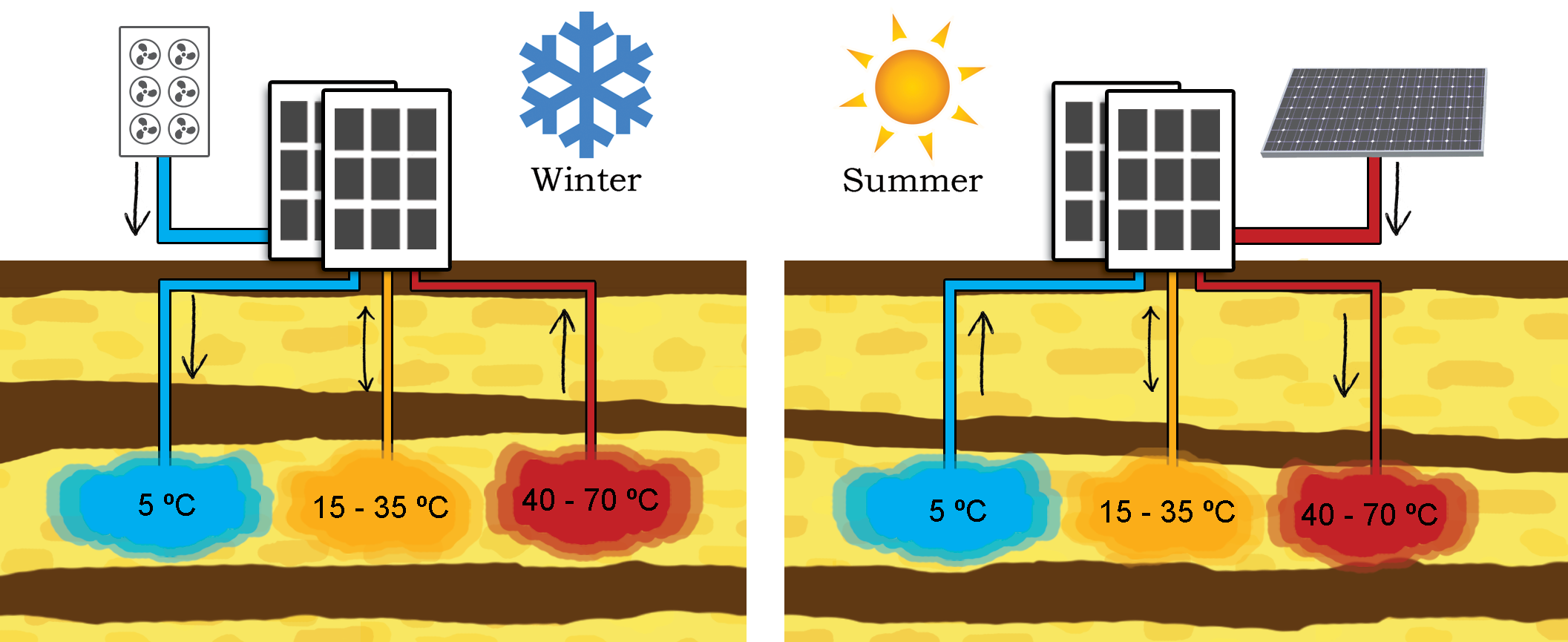Thermal energy storage for fully autarkic renewable district heating and cooling networks
03/05/2023Dr. M.Bloemendal1,2, Prof. Dr.
P.J.Vardon1
1Delft
University of Technology
2KWR water research institute
As a result of climate change and
insulation measures (to accommodate low temperature renewable heat sources), the
cooling demand of buildings increases considerably in climates where heating is
normally dominant. It is at least remarkable that cooling is hardly mentioned
or even considered in the heat transition. However, it is fairly
straightforward to also provide sustainable cooling with renewable heating
systems that use a heat pump. When such systems also use the subsurface as a
source for environmental heat, the cooling capacity stored in winter (while
extracting energy for heating) is available for cooling. Due to the typical
temperatures in which the thermal energy can be stored in the subsurface, so-called
passive free cooling can be used where only circulation of water is needed
without a heat pump. This is hyper cost-efficient cooling, usually with a COP
ranging from 20-30!
In individual buildings, such heating and
cooling systems are often supplied by aquifer or borehole thermal energy
storage (ATES/BTES) systems. Similarly, this can also be done in district
heating networks where seasonal heat storage is utilised. This could be done
with a single delivery set for the underfloor heating and cooling in each
building.
There are two key issues for the heating
and cooling of buildings to ensure comfort and reliability: energy supply and the
required temperature level. These are quite different in character to the
supply of electricity. Both heating and cooling are useful – just at different
times of the year – and can be considered positive and negative energy flows to
a building. The temperature of supply strongly impacts the needed internal
design and changing temperatures, e.g. via a heat pump, which uses a
considerable amount of energy.
Thermal energy storage systems are as just
that: storage systems. The energy that they supply must come from elsewhere.
For buildings or collections of buildings which have balanced heating and
cooling demands, energy is moved in time and space, and no additional supply is
needed. However, buildings in general do not have an even heating and cooling
demand. When there is a structural imbalance between heating and cooling,
additional sources can be utilised, e.g. cold water from a nearby surface water
could be stored during the summer for cooling purposes next winter.
Seasonal storage also adds the possibility
for large scale systems to effectively harvest local additional heat or cooling
capacity. Such systems, where district heating and cooling networks supply to
50-500 individual houses or equivalent other buildings, can benefit greatly
from the buffering capacity the underground can provide. Several of such
systems have been installed in in the Netherland, e.g. the Houthavens in
Amsterdam, in Dutch: https://warmtenetwerk.nl/warmteproject/koude-en-warmte-houthavens-3/.
For heating, there remain relatively few
buildings which can be directly heated at temperatures which are typically
stored in the subsurface (ATES systems are usually limited in the Netherlands
to 25°C). These are very new high-standard buildings, and the energy transition
needs to address all buildings.
Therefore a heat pump is usually an essential yet costly feature of such
systems, And has other disadvantages such as increasing electrical demand which
increases costs and puts strain on the electricity network. The efficiency of
thermal energy storage systems can be improved by utilising external higher temperature heat
sources to improve the heat pump coefficient of performance (reducing the
external electricity input), similarly as was done at the greenhouse of
Koppert-Cress https://www.egec.org/wp-content/uploads/2023/02/Bloemendal-Transition-of-ATES-to-HT-ATES-117_ExtAbstract.pdf.
However, by doing this, the cooling capacity generated by using the heat pump may
be reduced or even eliminated. In the latter case, the cooling capacity should also
be harvested from external sources, as was done at the project in Amsterdam
mentioned above. In that case, the BTES/ATES systems need to consider layouts
which take into account supply and return temperatures from buildings at
different times during the year. For example, for ATES systems, an additional
well is needed and should be laid-out similarly to the ATES-TRIPLET system https://www.tudelft.nl/2020/citg/geo-engineering/nwo-ates-triplet-project-granted.
This means that by sourcing the right amount of thermal energy at the right
temperature, and being able to store it seasonally, the amount of external
energy can be reduced, even to zero – creating fully autarkic district
heating and cooling networks!
All in all, seasonal underground thermal
energy storage is key in enabling renewable district heating and cooling grids.
It provides the key buffer between heating and cooling supply and demand – even
when heating and cooling energy demands are not balanced. Common practices exist,
but also some research challenges lie ahead of us to further optimise these
technologies and make them suitable in wider areas of the world.
